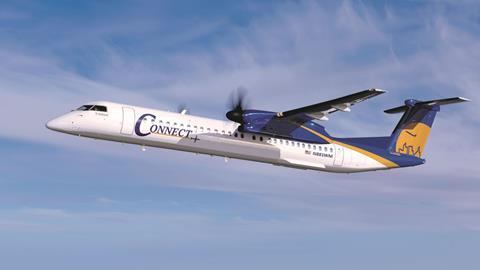The first flight of a De Havilland Canada Dash 8-300 powered partly by a hydrogen fuel-cell propulsion system is just the beginning of start-up Universal Hydrogen’s strategy to decarbonise airline travel.
Completed to much fanfare on 2 March before reporters and potential investors, the roughly 15min flight from Moses Lake in Washington was a major milestone in the eyes of co-founder and chief executive Paul Eremenko, who toasted to “a new golden age of aviation”.
“I am beside myself with jubilation,” Eremenko tells FlightGlobal. “It’s a big deal. I couldn’t wish for a better day.”

Touted by Universal Hydrogen as “by far the largest fuel-cell powered airplane ever to fly,” the retrofitted Dash 8 with a splashy livery performed a climbing turn and two flyovers of Grant County International airport. On the second fly-by, the pilot throttled back the aircraft’s Pratt & Whitney PW123 turboprop and let the Dash 8 cruise principally on thrust from its hydrogen power plant.
The first flight is the latest accomplishment in the field of hydrogen-powered aviation. In January, hydrogen-electric aircraft developer ZeroAvia successfully completed the first flight of a Dornier 228 converted to run partly on hydrogen fuel cells, with the aircraft conducting a 10min flight in southwest England.
Significant hurdles remain for such technologies to enter the market, however. “Hydrogen fuel cells, a clean energy source whose only emission is water, have yet to achieve use in powering large aircraft due to engineering challenges associated with weight, temperature and electrical loads,” NASA said in November, noting that “new research demonstrates there may be a way forward”.
Universal Hydrogen, which has for several years been developing a hydrogen fuel-cell modification kit for Dash 8s and ATR turboprops, maintains that it is on the right path to achieve zero-emissions aviation.
“Our first product will be an ATR,” says Eremenko, formerly of Airbus and United Technologies (now Raytheon Technologies). “We initially had a hypothesis that the Dash 8 would be the first product, and then we changed our minds based on airline demand and the fact that De Havilland took the Dash 8 out of production.”
The Dash 8 makes an ideal test bed for Universal Hydrogen’s technology because “it is a very laterally stable airplane” thanks to its “humongous vertical tail,” he explains. “If you’re flying in an asymmetric thrust kind of configuration intentionally, as we did, it’s a very suitable subject.”
The California-based company said on 7 February it had received a special airworthiness certificate in the experimental category from the Federal Aviation Administration, allowing it to begin testing its demonstrator aircraft.
Universal Hydrogen intends to obtain a supplemental type certificate for modifying existing airplanes and enter the market in 2025. It will focus first on retrofitting the existing fleet of regional turboprop aircraft, hoping to “ultimately penetrate half the market over 10 or 15 years”, Eremenko says.
“There’s a question of why would anybody not do it? Because the unit economics looks really good,” he says. “We believe that we can offer equivalent CASM [cost per available seat mile] starting in 2025 at entry to service, and improved CASM over jet fuel or SAF over subsequent years.”
Eremenko envisions retrofitting regional aircraft with hydrogen power plants as a stepping stone to developing similar propulsion systems for narrowbody jets – those the size of Boeing 737s and Airbus A320s.
“The single-aisle is the dominant source of emissions in aviation,” he says. “More than 50% of all aviation emissions come from that class of airplanes, and both of those families of aircraft are due for a new clean-sheet design. I think the 737 Max debacle finally put a stake in the heart of further derivatives.”
With both Airbus and Boeing targeting the mid-2030s for entry to service for the next generation of narrowbodies, Eremenko believes they will likely have designs locked in later this decade. His ambition is that those designs would incorporate Universal Hydrogen’s fuel-cell propulsion system, supported by a hydrogen-fuel distribution network using hydrogen tanks the company calls “modules”.
“In that sense, regional is a stepping stone, because by 2025 we will have real passenger butts in seats, flying with real unit economics and a fully certified airframe, a certification basis with the regulators, and a fuel logistics system that can span and scale up to thousands of commercial airports in the world,” he says. “If you were to ask Airbus or Boeing today, ‘Why not hydrogen?’, those would be the things they would say, and I think we’re going to retire most of the principle risks associated with it.”

Airbus has its own ambitions of developing the world’s first zero-emission aircraft by 2035 with three conceptual aircraft, under its ZEROe programme, that would be powered by a proposed hydrogen fuel-cell energy system.
Embraer also recently unveiled several new conceptual low-emission aircraft, shifting away from previous plans to develop an all-electric commuter aircraft under its “Energia” programme and toward possible development of larger aircraft powered by hybrid-electric and hydrogen propulsion.
Others have taken a more sceptical approach. In 2020, Boeing’s top product developer expressed doubts that hydrogen-powered airliners would be viable in the near future due to technical and regulatory hurdles. And in 2021, a Raytheon engineer and technology executive said that hydrogen “burns easy” in turbofans but has “mass and infrastructure limitations”.
Hydrogen has more energy density than the same mass of jet fuel, but takes up much more space, meaning hydrogen-fuelled aircraft could require comparatively much larger, heavier fuel tanks. Such requirements could leave such aircraft carrying fewer passengers than conventionally powered types and require incredibly expensive development programmes, some sceptics predict.
Storing hydrogen on board is technically difficult, Airbus noted in 2021: “Hydrogen may provide more energy by mass than kerosene fuel, but it delivers less energy by volume. At normal atmospheric pressure and ambient temperature, you would need approximately 3,000 litres of gaseous hydrogen to achieve the same amount of energy as one litre of kerosene fuel.”
HUGE OPPORTUNITY
Universal Hydrogen has 247 orders for its fuel-cell modification kits, Eremenko says. One of its early customers is new US carrier Connect Airlines, which plans to become the first to use the technology for regional passenger service when it comes online.
Connect, having recently completed trials with the FAA, plans to begin service this spring using four Dash 8s. But the Boston-based carrier still has regulatory hurdles to clear with the US Department of Transportation and Transport Canada before operating planned flights from Philadelphia and Chicago to Toronto.
Connect has orders to convert 75 ATR 72s with hydrogen power trains, and purchase rights for an additional 25 conversions, says Scott Brownrigg, the airline’s director of public affairs.
“There are approximately 1,400 regional jets flying in the US domestic regional market, and we think there’s a huge opportunity to replace some of those ageing fleets with smaller aircraft that can fly on hydrogen,” Brownrigg says. “Of course, the technology has to catch up to the aspiration as we get through into larger planes. But it’s just the beginning, and this is the most realistic route to zero-emission aviation.”
Connect is not concerned with the infrastructure logistics of powering a fleet of turboprops with hydrogen fuel cells, Brownrigg says.
“The greatest part of the Universal hybrid technology is that they’re building a system which they describe as like an espresso pod that you can plug into the plane,” he says. “They can use existing infrastructure at airports.”
Indeed, the idea behind Universal Hydrogen’s “modular fuel distribution approach” is that it will require no modification to existing airport shipping and fuelling systems, Eremenko says.
“If you look at our hydrogen module, it looks an awful lot like an LD3 [shipping container] upside down,” he says. “If your airport can handle LD3s, you can use our hydrogen modules. That is a design constraint we have imposed on ourselves – no new infrastructure at the airport.”
Eremenko asserts that Universal Hydrogen’s plan to be incorporated into Airbus and Boeing’s next-generation aircraft designs may be the only realistic way for the industry to reach its zero-carbon target by 2050. He points to the prohibitive weight of lithium ion batteries and land-use issues associated with scaling production of sustainable aviation fuel as reasons why hydrogen fuel-cells are the most “plausible” path forward.
“It’s urgent because we’ve got to start with regional in the mid-2020s,” he says, “so that the narrowbody decision in the late 2020s is the right one.”



















